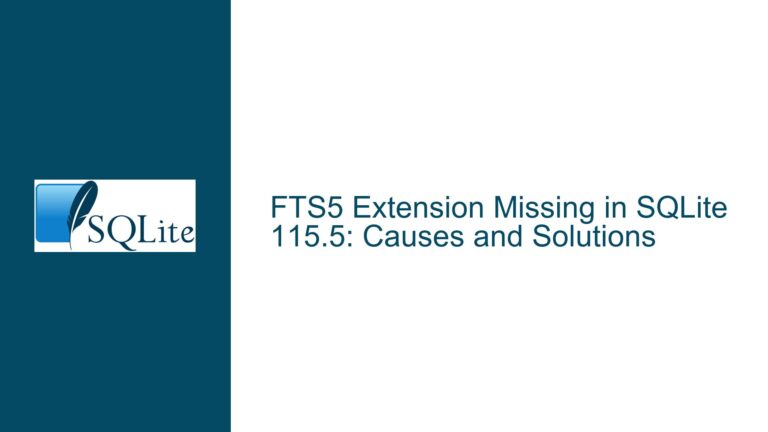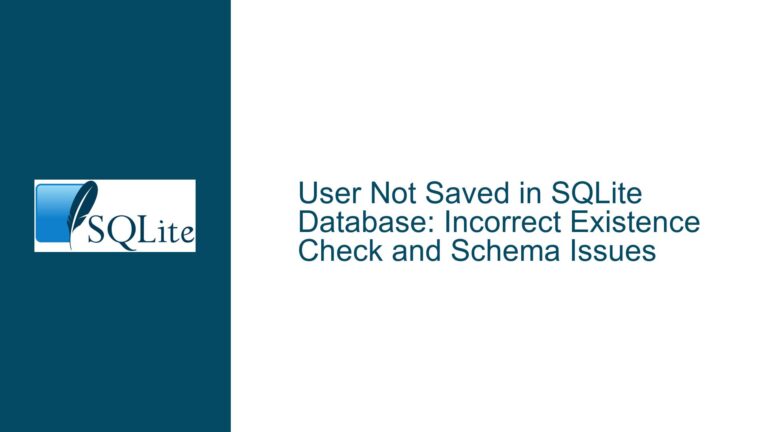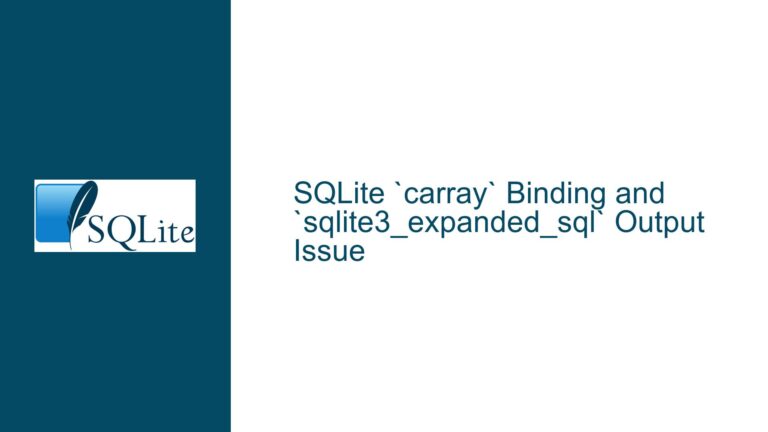SQLite CLI Dot Command Abbreviation Rules and Ambiguity Risks
How SQLite CLI Parses Dot Command Abbreviations and Resolves Ambiguities
The SQLite command-line interface (CLI) uses a set of dot commands (e.g., .mode, .parameter, .width) to control its behavior and interact with databases. A common question arises: Why do some commands allow shorter abbreviations than others, and why do certain abbreviations unexpectedly trigger unintended commands? For example, .m, .mo, and .mod all resolve to .mode, but .parameter requires at least .par instead of shorter prefixes like .pa. This behavior is rooted in the CLI’s parsing logic, which balances convenience with the need to avoid ambiguity. Misunderstanding these rules can lead to severe consequences, such as scripts inadvertently executing unintended commands (e.g., .w switching a database to WAL mode instead of setting column widths).
This guide dissects the CLI’s abbreviation resolution mechanism, explains why ambiguities arise, and provides actionable strategies to diagnose and resolve issues caused by abbreviated dot commands.
Core Mechanics of Dot Command Abbreviation Resolution
The SQLite CLI processes dot commands by comparing user-input abbreviations against the full command names using a prefix-matching algorithm with additional constraints. The algorithm operates in three stages:
First-Character Filtering:
The CLI first checks the first character of the input to narrow down the list of candidate commands. For example, if the input starts withp, the CLI only considers commands beginning withp, such as.print,.parameter, or.prompt.Prefix Matching:
The CLI then verifies that the input string is a prefix of a full command name. For example,.modis a valid abbreviation for.modebecause "mod" is the first three characters of "mode." However,.pais not accepted for.parameterif the CLI determines that a longer prefix is required to avoid ambiguity.Hard-Coded Minimum Length Checks:
Some commands enforce a minimum abbreviation length to resolve conflicts. For instance,.parameterrequires at least three characters (.par) because shorter prefixes like.pacould ambiguously match other non-existent commands. These minimums are often hard-coded in the SQLite source code.
Case Study: .parameter vs. .print
The CLI’s source code (shell.c) includes explicit checks for certain commands. For .parameter, the check is:
if( c=='p' && n>=3 && strncmp(azArg[0], "parameter", n)==0 ){ ... }
Here, n>=3 enforces a minimum length of three characters for the abbreviation. This prevents .pa (length 2) from resolving to .parameter, even though no other p-prefixed command starts with pa. In contrast, .print does not require such a check because its shorter abbreviations (e.g., .pr) do not conflict with other commands in the p group.
Why Abbreviations Fail: Ambiguity, Evolution, and Hard-Coded Constraints
Three primary factors cause unexpected behavior with dot command abbreviations:
Ambiguity Due to Command Overlap
When multiple commands share the same starting characters, the CLI requires longer prefixes to disambiguate them. For example, if two commands existed starting withpa,.pawould be rejected. However, even when no conflict exists today, SQLite’s conservative parsing logic may enforce minimum lengths to guard against future conflicts.Changes in Command Sets Across SQLite Versions
Newly introduced commands can invalidate previously safe abbreviations. A real-world example occurred when.widthwas abbreviated to.win a script. When SQLite introduced.wal(Write-Ahead Logging mode), the.wabbreviation resolved to.walinstead of.width, altering the database’s journaling mode unexpectedly.Source-Code-Level Minimum Length Enforcement
Some commands have minimum abbreviation lengths hard-coded into the CLI’s logic. These are not derived from the current set of commands but are instead safeguards added by developers. For example,.parameter’s three-character minimum is arbitrary and not based on existing conflicts.
The Role of the shell.c Logic
The CLI’s command-handling code in shell.c uses a series of if–else blocks grouped by the first character of the command. This structure means that:
- Commands are checked in alphabetical order within their first-character group.
- The first matching prefix wins, so command order in the source code affects resolution.
- Some commands include additional conditional checks (e.g., argument counts) that influence abbreviation validity.
Diagnosing and Resolving Abbreviation-Related Issues in SQLite Scripts
Step 1: Audit Scripts for Ambiguous Abbreviations
- Use Full Command Names: Replace all abbreviated dot commands with their full names (e.g.,
.widthinstead of.w). This eliminates ambiguity and future-proofs scripts against new commands. - Identify Risky Abbreviations:
Cross-reference script commands with the official list of SQLite dot commands. For example,.wis risky because it could resolve to.width,.wal, or any futurew-prefixed command.
Step 2: Analyze the CLI’s Parsing Logic for Specific Commands
- Inspect the
shell.cSource Code:
Search for the target command in theshell.cfile (e.g.,parameter). Look for conditional checks liken>=3, which indicate minimum abbreviation lengths.// Example: .parameter requires at least 3 characters if( c=='p' && n>=3 && strncmp(azArg[0], "parameter", n)==0 ){ ... } - Test Abbreviations Interactively:
Use the SQLite CLI to test how abbreviations resolve. For example:sqlite> .pa... Error: unknown command or invalid arguments: "pa". Enter ".help" for help. sqlite> .par... Usage: .parameter OPTIONS... Manage SQL parameter bindings
Step 3: Mitigate Version Compatibility Risks
- Pin SQLite Versions in Scripts:
If scripts rely on ambiguous abbreviations, specify the SQLite version required (e.g.,sqlite3 --versioncheck) to prevent unintended behavior in newer versions. - Update Scripts After SQLite Upgrades:
Review the changelog for new dot commands when upgrading SQLite. For example, the introduction of.walin version 3.7.0 necessitated updates to scripts using.w.
Step 4: Implement Defensive Scripting Practices
- Use Aliases for Clarity:
Wrap SQLite CLI invocations in shell scripts that substitute safe abbreviations with full names:# Replace .w with .width in all scripts sed 's/\.w /.width /g' legacy_script.sql > updated_script.sql - Add Validation Checks:
Include pre-execution checks to verify that abbreviations resolve as expected:-- Check if .w resolves to .width .w 10 20 .show -- Verify column widths are set, not WAL mode
Step 5: Advocate for CLI Enhancements
- Request a Strict Mode:
Propose a CLI option (e.g.,--strict-dot-commands) that disables abbreviation resolution and requires full command names. This would prevent future ambiguity in scripts. - Contribute to Source Code Clarity:
If a command’s minimum abbreviation length is unnecessarily restrictive (e.g.,.parameterrequiring.par), submit a patch to relax the check when no conflicts exist.
By understanding the CLI’s abbreviation logic, proactively auditing scripts, and adopting defensive coding practices, users can avoid unexpected behavior caused by dot command ambiguities. Always prioritize full command names in scripts and stay vigilant when updating SQLite versions.






